Over the last couple of years I’ve been struck by the number of times that I’ve watched Black Guillemots fly past me at Fife Ness. Although there is some evidence that Black Guillemots may have bred on the Isle of May up until 1850, it has historically been scarce in mainland Fife, with its frequency declining as the 20th Century progressed (Smout, 1986). The frequency of birds passing Fife Ness recently didn’t quite fit with this and so I decided to take a closer look.
This note summarises observations of Black Guillemot in mainland Fife between1980 and 2023. It excludes the Isle of May because a) the May has its own bird recording area that is separate from the rest of Fife and b) observer effort on the Isle of May has been extremely patchy over the decades (and can be practically zero for large parts of the year). Observations have been gathered from Fife Bird Reports up to 2018, and for 2019 to 2023 from the Fife Bird Club monthly newsletter sightings summaries and WhatsApp group. No attempt has been made to determine whether records might refer to the same individual/s and so this note summarises observations reported, rather than number of birds that may be involved.
Change in Frequency of Observations Since 1980
In total, there were 233 records of Black Guillemots in mainland Fife between 1980 and 2023. There have been three years since 1980 with zero records of Black Guillemot from mainland Fife: 1983, 2011 and 2012. Between 1980 and 2019, there were a total of 138 records of Black Guillemot, averaging just over three per year, and although the numbers fluctuated there was no clear trend over those four decades. However, from 2020 there has been a marked increase in the number of records, with ten, 18 and 17 observations during 2020, 2021 and 2022 respectively, followed by a very dramatic jump to 50 records during 2023.
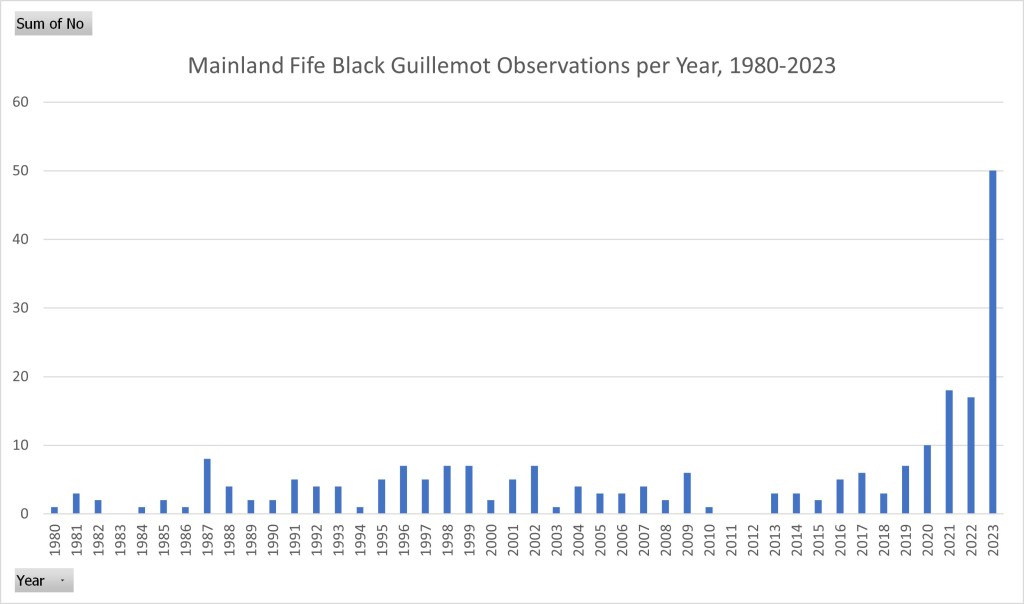
When to Look for Black Guillemot in Fife
Black Guillemots have been observed throughout the year in mainland Fife, with 20 or more observations during January, February, March, September, October, November and December. The month with the highest total is October (36), and the months with the fewest observations were June (5) and July (6). It is perhaps not a surprise that the greatest number of observations was during October, a month in which birds will be undertaking post breeding dispersal but also, and perhaps more importantly, when extensive birding, including seawatching, effort takes place.
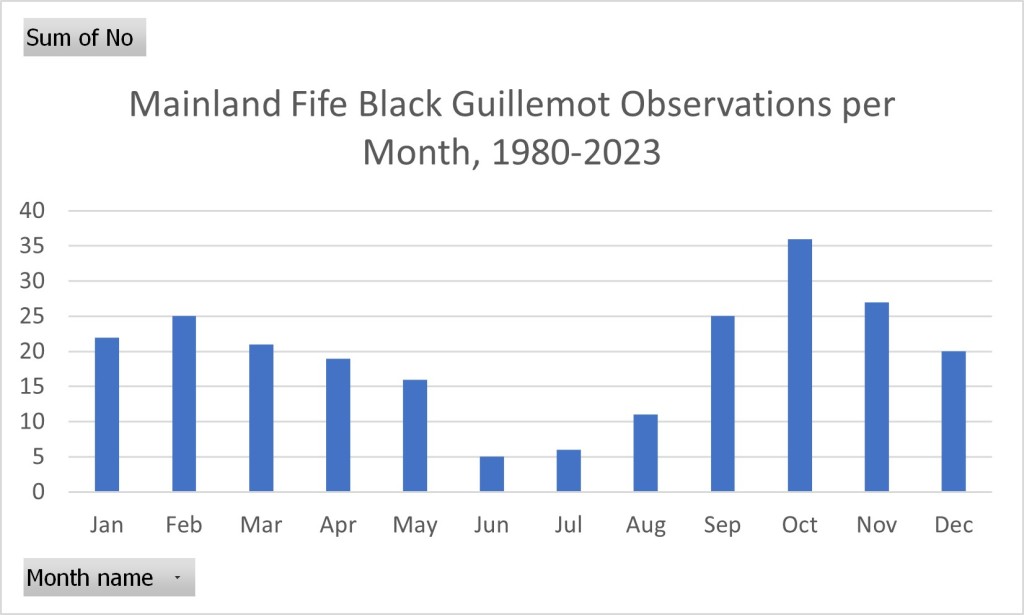
However, when considering which time of year Black Guillemot may occur most frequently it may be important to consider the amount of effort being expended birding in suitable areas, as it may be the case that peaks in observations coincide with peaks in effort. One way that effort can be accounted for is to use information from Fife Ness on the number of hours spent seawatching and the number of Black Guillemots observed to produce an observation rate e.g. average number of Black Guillemots observed per hour of seawatching. When plotted for each week of the year it becomes apparent that, at Fife Ness at least, October does not have a particularly high passage rate, and that actually November to March have the highest passage rate.
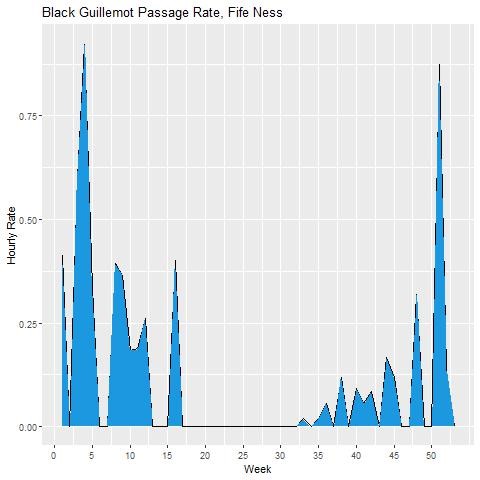
Where to Look for Black Guillemot in Fife
Black Guillemots have been observed right around the Fife Coast, but the East Neuk, Largo Bay, and Kirkcaldy areas have the greatest number of sightings. The individual locations with the highest numbers of observations are Fife Ness (96), Ruddons Point (29), Largo Bay (13), Anstruther (13), Kinghorn (13), and Lower Largo (12).
The dominance of Fife Ness is perhaps not a huge surprise considering the high level of seawatching effort at the site. Observing Black Guillemots flying past during seawatches will also be less influenced by sea state, something that can have a very significant impact on the likelihood of detecting a bird on the water. It is very unusual to see birds on the sea at Fife Ness, and when they are it is almost invariably because they have been seen flying in and landing, rather than them being initially detected on the water. So, if you want more protracted views than is possible with a bird flying rapidly by, a visit to Largo Bay rather than Fife Ness may be the best strategy.
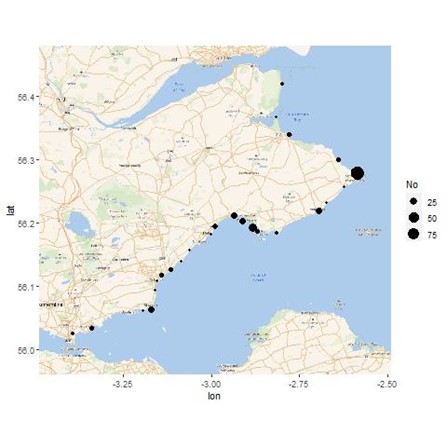
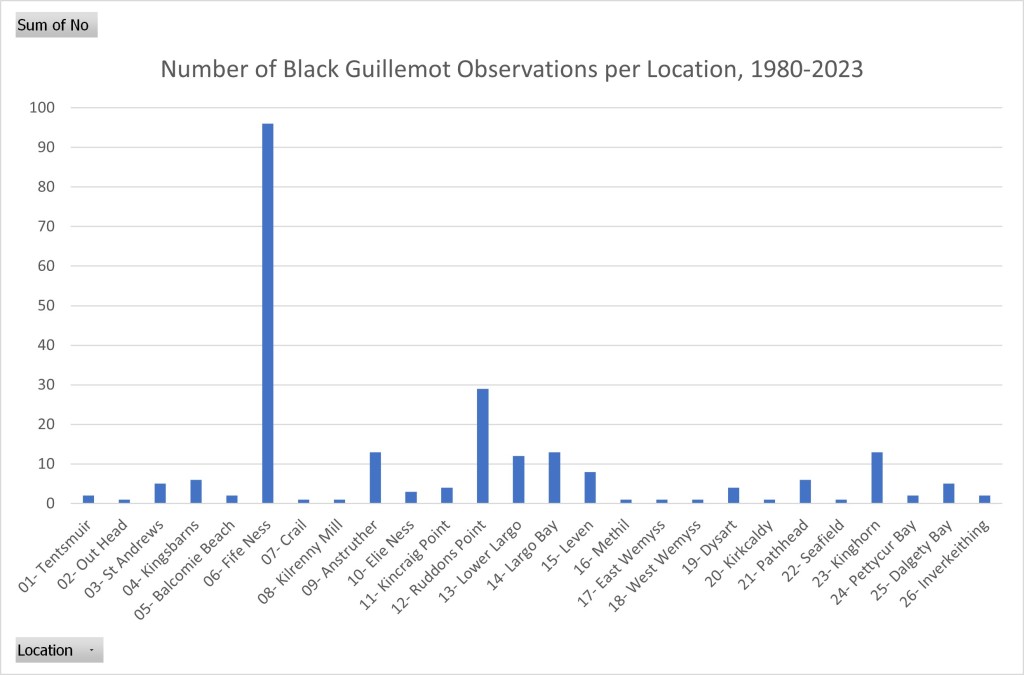
Some of the Fife Ness observations will undoubtedly relate to the same individual birds commuting between foraging areas in the Forth and north coast of Fife, but it is also clear that multiple individuals can be present. For example, during early March 2023, based on the degree of moult into breeding plumage at least three individuals were present, whilst in December 2023 four individuals flew south during a one hour seawatch. There have been records of two birds at St Andrews Bay (once), Fife Ness (nine occasions), Anstruther (once), Ruddons Point (three occasions), Lower Largo (once), Leven (once) and Dysart (once). The highest count in Fife was the record of four birds south past Fife Ness during an hour on 22 December 2023.
Influence of Observer Effort?
A key reason for the marked increase in the number of observations of Black Guillemots in mainland Fife in recent years is likely to be birder effort. The increase in time spent seawatching at Fife Ness during the early 2020s seems to be the principal cause of the increase in records at this site. The influence of Fife Ness on the number of mainland Fife observations in recent years can be seen in the graph below, where observations from Fife Ness (virtually all by just one observer, me) are highlighted in orange. Although the recent increase in observations is still apparent even if records from Fife Ness are discarded, it is clear that Fife Ness is the driver behind the dramatic increase during 2023.

One region of Fife that has perhaps had a reasonably consistent level of birder effort over the last 40 years is likely to be Largo Bay (Leven, Lower Largo, Ruddons Point). The presence of wintering seaduck, grebes and divers, and for large parts of this period wintering Surf Scoter, has meant that the area is checked relatively frequently by observers using ‘scopes. This is likely to mean that Black Guillemots present would have a reasonably consistent chance of being detected. The number of observations in Largo Bay if anything showed a decline during the 2000s, with multiple years with zero observations. This trend may now be reversing, with an increase suggested by the number of observations reported during 2022 and 2023.
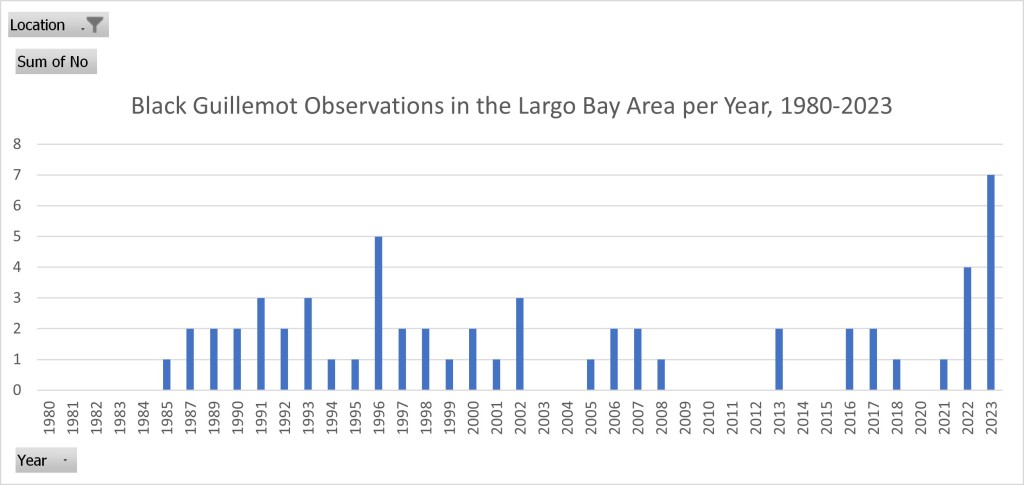
Influence of Population Change in NE Scotland?
Whilst observer effort undoubtedly explains a large proportion of the recent increases in number of observations of Black Guillemots in mainland Fife, the recently published Seabirds Count A census of breeding seabirds in Britain and Ireland (2015–2021) (Burnell et at 2023) indicates a dramatic increase in the breeding populations closest to Fife: an 856% increase from nine to 86 individuals in Moray, a 133% increase from three to seven at Kincardine to Inverclyde, and the appearance of small breeding populations in Aberdeen. It seems likely that these changes may at least in part explain the recent increase in observations in Fife, rather than it being driven solely be observer effort.
Conclusion
The information collated here suggest that it is worth looking for Black Guillemots ‘anywhere’ around the Fife coast during calm seas and good light conditions, but there are clearly some sites where chances are better than others. For fly-past birds, Fife Ness is the best bet any time between October and March, but for seeing birds on the sea the wider Largo Bay area appears to be most promising. It will be interesting to see whether the apparent increasing trend of the last few years continues into the future.
References
Burnell, D. Perkins, A. J., Newton, S. F., Bolton, M., Tierney, T. D., Dunn, T. E., (2023). Seabirds Count. A census of breeding seabirds in Britain and Ireland (2015–2021). Lynx Nature Editions.
Smout, A-M. (1986). The Birds of Fife an Outline of Their Status and Distribution. Edinburgh: John Donald
Jared Wilson, December 2023
